
Jeep Grand Cherokee 75th Anniversary Edition 2017 review
Tim Robson has been testing the US convention that bigger is always better, behind the wheel of the 2017 Jeep Grand Cherokee 75th Anniversary Edition.
Browse over 9,000 car reviews
I know what you’re thinking; this new Land Rover Discovery has gone a bit soft.
It’s built on the road-focused Range Rover Sport platform now. It’s lighter. And safer. Better equipped. Less, well, square. Hell, it’s even offered with a choice of two tiny four-cylinder engines, along with the traditional V6 unit.
And all of that surely means it’s just a little less rugged than the cars that have gone before it, right?
But Land Rover assures us that is actually not the case, declaring this all-new, fifth-generation car the most capable Disco ever.
So have they gone stark Rovering mad?
| Land Rover Discovery 2017: TDV6 Graphite | |
|---|---|
| Safety rating | |
| Engine Type | 3.0L turbo |
| Fuel Type | Diesel |
| Fuel Efficiency | 8.8L/100km |
| Seating | 5 seats |
| Price from | $45,540 |
It’s a complicated lineup, with three engines available in any of the four trim grades, which in turn are offered with five or seven seats, plus there’s a launch special called the First Edition to further muddy the waters.
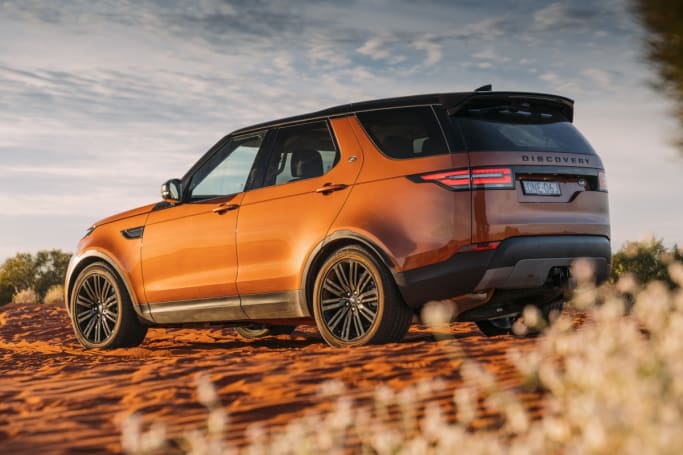
And that means you can technically climb into a pared-back Discovery S for a low $65,960 for a five-seater, or stretch to $131,870 for a full-fruit launch edition, with the vast area between those two numbers populated by everything else.
The entry-level S ($65,960 - $84,671) is a fairly simple offering, with 19-inch alloys, cloth seats, a leather-wrapped wheel with paddle-shifters and two-zone manual climate control the pick of a sparse standard inclusions list. Cruise control is also standard fit, as is a raised inner-boot guard that stops your luggage falling out when you open the boot.
Step up to the SE ($77,050 - $94,701) and you’ll add standard air suspension, with fixed height settings for off-road, normal and access (which lowers the car if you need to pass under a low roof, for example), along with rain-sensing wipers and powered and heated wing mirrors.
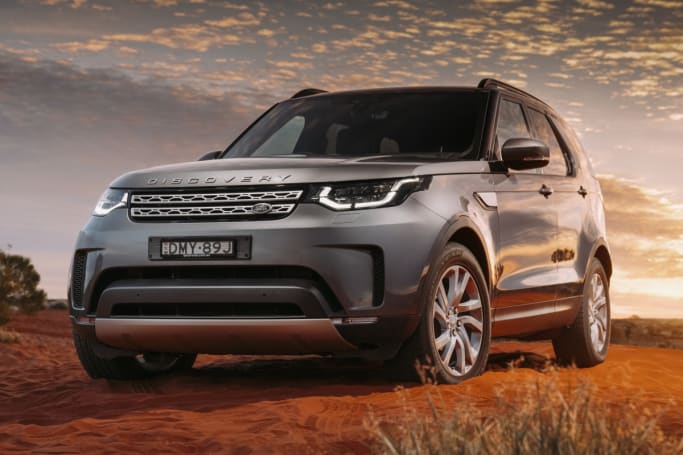
LED headlights (with an undeniably cool Nike Swoosh-style design) and leather seats also join the party at the SE level, as does ambient interior lighting and front parking sensors, while your eight-inch touchscreen is now nav-equipped, and pairs with a better, 10-speaker stereo.
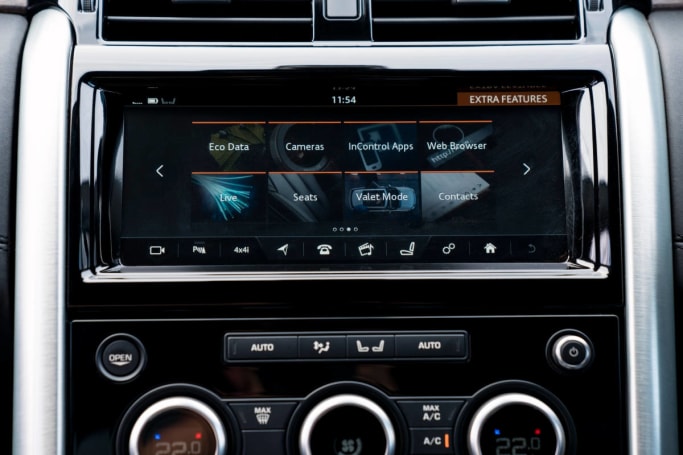
Next is the HSE trim ($87,150 - $103,661), which adds some cool design elements, like LED taillights, 20-inch alloys outside, along with winged headrests, quality woodgrain highlights and even more ambient lighting inside. Your climate is now three-zone, too, and some bonus hiding holes appear (like a clever storage compartment under the front cupholders that only appears when you slide the unit forward). Your stereo is upgraded to a 10-speaker Meridian unit, too, and is controlled through a bigger, 10-inch touchscreen.
At the top of the regular Disco family tree, is the HSE Luxury ($100,950 - $117,461), which is a not-insignificant amount of money no matter which way you shake it. For that spend, though, you’ll add a powered sunroof, unique 20-inch alloys and finer leather on your seats, which are now also heated and cooled in the front. You’ll also add a surround-view camera and get the pick of the sound-systems; a 14-speaker Meridian unit.
On the 4WD front, everything but the entry-point S models get a low-range-equipped 4WD system (the S is high-range only), and Range Rover's Terrain Response (which allows you to select traction settings based on the whether you're driving one mud, rocks, sand etc) is standard across the range. The newer Terrain Response 2, which automatically senses the surface and adjusts accordingly, is a cost option.


Land Rover has attempted a sleeker, more urban design this time around, only without losing all of its boxy heritage, and the results are, well, a little confusing.

Viewed front on, this new Disco looks smooth and powerful, with a narrow bonnet that drops into the flared arches of the front wheels adding instant road presence. And from the rear it looks good, too.
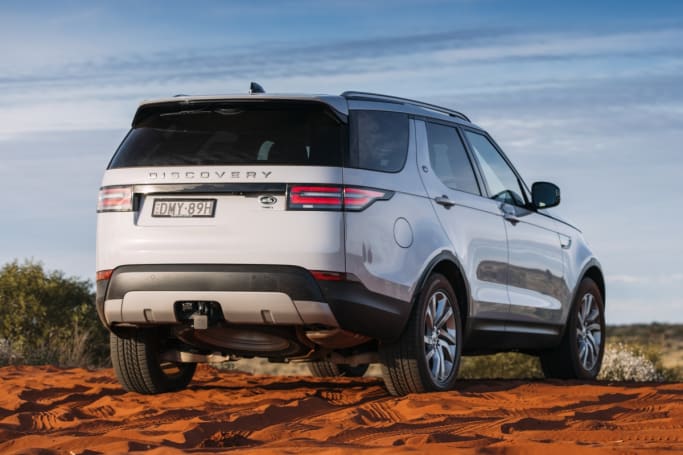
Some will argue that the offset numberplate is an over-indulgence, or that it looks a little fridge-like with its narrow and tall dimensions, but we like it.
But it’s the three-quarter view that’s a little hard to stomach, with the smooth lines of the front end meeting the squared-off rear with all the subtlety of a wave meeting the shoreline.
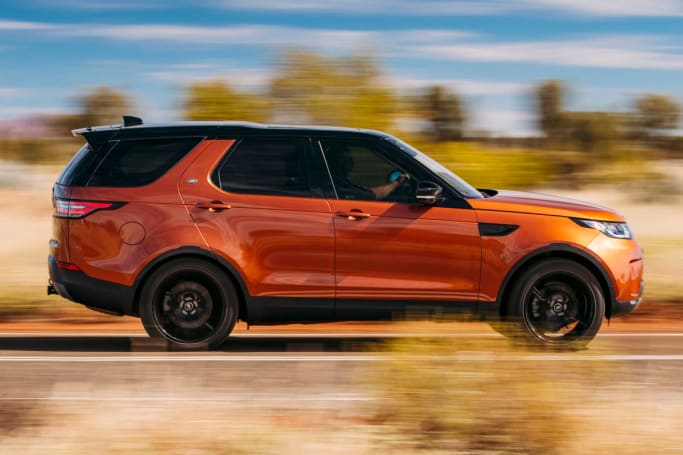
Inside, though, it’s a picture of premium, with soft-touch cabin materials and a stylish, unfussy dash setup oozing a sense of considered quality.
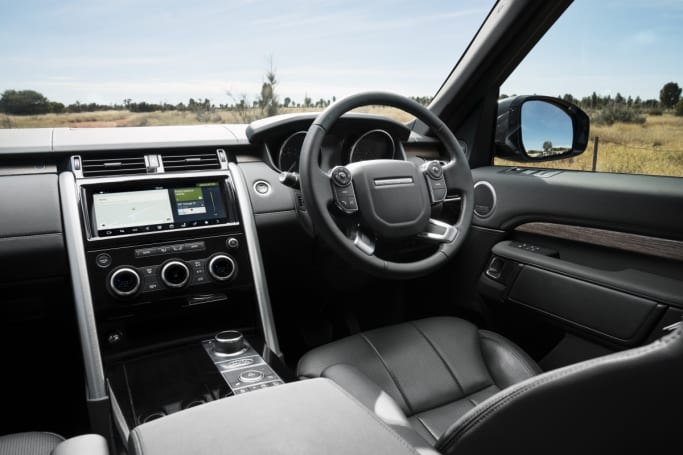
Perhaps unsurprisingly, given it’s the size of small apartment block, the Disco’s people-and-cargo-carrying abilities are first rate. The official dimensions are 4970mm are long, 1846mm high and 2220mm wide, but that translates most simply as bloody massive.
Up front, there’s plenty of space for front-seat riders, though the super-wide central unit that runs from the dash to the centre console and houses everything from the touchscreen unit to the 4WD controls does eat into knee room a little. Front seat riders will share two central cupholders, and there’s room in the all doors for bottles.
Climb into the massive second row (it’s three-adults-across-the-middle big) and you’ll find your surroundings hinge on what trim level you’re in, with top-spec models adding climate control functions, dual USB points and two cupholders housed in a pulldown divider.
Opt for a seven-seat model (and you probably should) and you’ll find access to the third row a little tricky, but once there the space is genuinely impressive. At 176cm, I’m far from the tallest tester, but I do consider myself adult-sized, and I had clear air between my knees and the seat in front, and between my head and the ceiling.
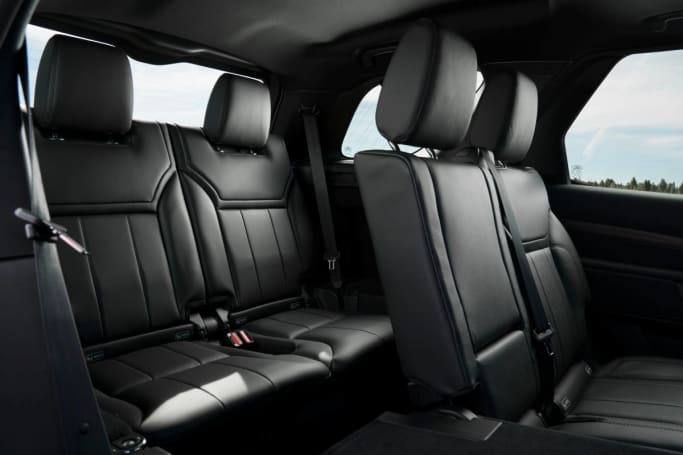
Flatten the second and third seat (which you can do remotely via an app, should you so wish) and you’ll be able to squeeze 2,500 litres of cargo on board, helped by its two-metre load length and 1.4-metre load width. But drop only the third row and you’ll still get 1,231 litres. And you can add to that up to 21 separate storage areas that can add another 45 litres of space.
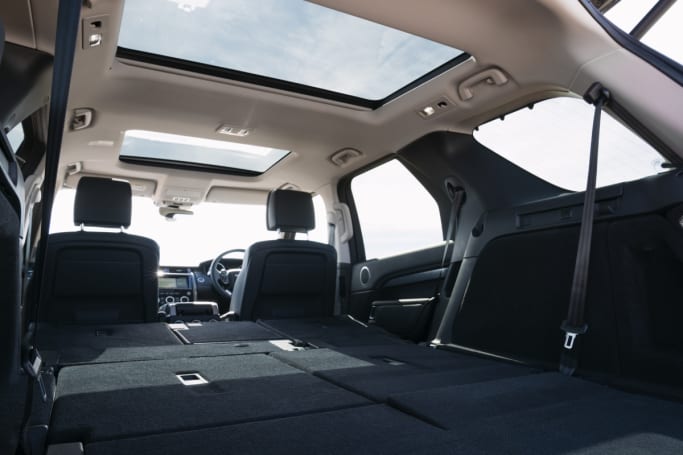
There’s also two or four ISOFIX attachment points, with two in the second row in all models joining another two in the third row for seven-seat cars.
There’s three diesel power plants on offer, and each pairs with an eight-speed automatic gearbox that channels power to all four wheels.
The entry level (and destined to be unpopular) option is the lesser of the two four-cylinder engines, 2.0-litre “Ingenium” unit that will deliver 132kW and 430Nm.

We’re yet to test the low-output option, to be honest, but we’d be shocked if buyers found it ample to shift the Disco’s bulk, even if this new model is a staggering 480kg lighter than its predecessor. Land Rover says that engine will help produce a 10.5-second sprint to 100km/h.
Better, then, to step up to the more powerful version of that engine, which produces 177kW and 500Nm thanks to some tuning tweaks. As a result, a far more palatable sprint time of 8.3 seconds can be achieved.
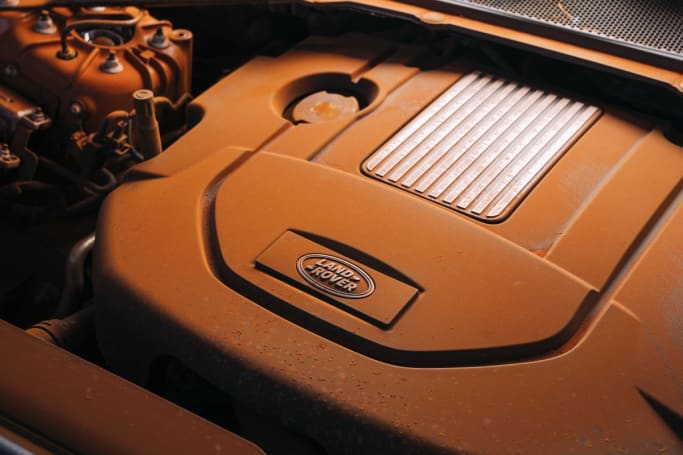
But for ours, the best-suited option remains the powerful 3.0-litre diesel V6, which will fire 190kW and 600Nm to the tyres on demand. And the result of all this extra grunt? A slightly improved sprint claim of 8.1 seconds. But those numbers don’t tell the full story of an engine that feels more urgent and eager when you prod the accelerator.
The lowest-output diesel will drink 6.3-litres per hundred kilometres on the claimed/combined cycle, with that number climbing to an only slightly worse 6.5 litres for the more powerful four-cylinder unit.
Opt for the V6, though, and your fuel use climbs to 7.2 litres per hundred kilometres (claimed/combined).
Land Rover is faced with the most impossible of challenges with this new Disco. For one, it’s filling in for the legendary Defender as the brand’s most capable offering, and that means it needs to be able to go places and do things a Range Rover simply can’t. Anything less will have the purists frothing.
But equally, Land Rover knows that the overwhelming majority of its customers are unlikely to tackle anything more challenging than a suburban speed bump, and so they needed to soften its image and improve its road manners, without sacrificing capability.
So Land Rover pointed the Disco’s nose towards Australia’s red centre, putting its fleet through their paces on the sealed roads and red dirt tracks that encircle Uluru. And on a custom-built track consisting of moguls, water crossings and angled climbs sharp enough to put some articulation pressure on the wheels, the Disco conquered all before it with ease.
It must be said, though, that there was nothing on offer that would genuinely challenge it, but equally, the Disco always felt like it had plenty in reserve, too. And with a maximum 283mm ground clearance, 500mm of wheel articulation and a wading depth of 900mm (which is 200mm more than outgoing model), along with air suspension on all but the entry-level S, it does point to some genuine off-road potential.
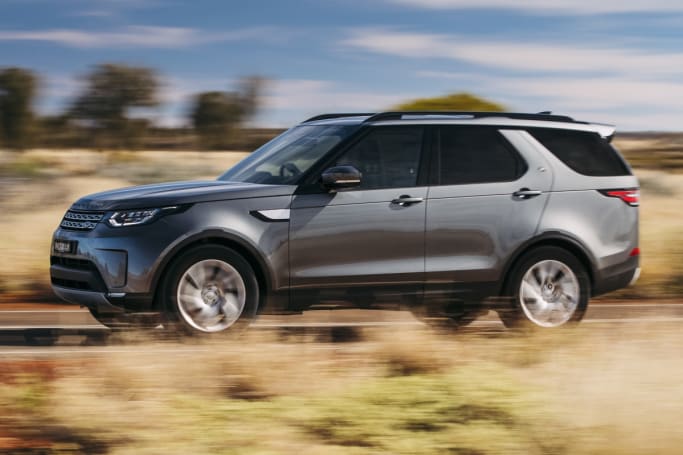
On our brief tarmac drive we were surprised by the smooth and steady power delivery of the bigger four-cylinder diesel, which propels the two-tonne-plus Land Rover along with surprising ease. It’s not fast, but it never feels underwhelming.
But the pick for us was the six-cylinder option, which unlocks its 600Nm low in the rev range and feels a far more natural fit for the big Disco. It’s louder and little more gruff than its four-cylinder sibling, but it feels faster, too. And for us, that’s a fair trade off.
The Disco happily switched from tarmac to rutted tracks with ease, and while the super-smooth tarmac of the Northern Territory wasn't much of a challenge, it sorted out the worst of the off-road stuff with little bother.
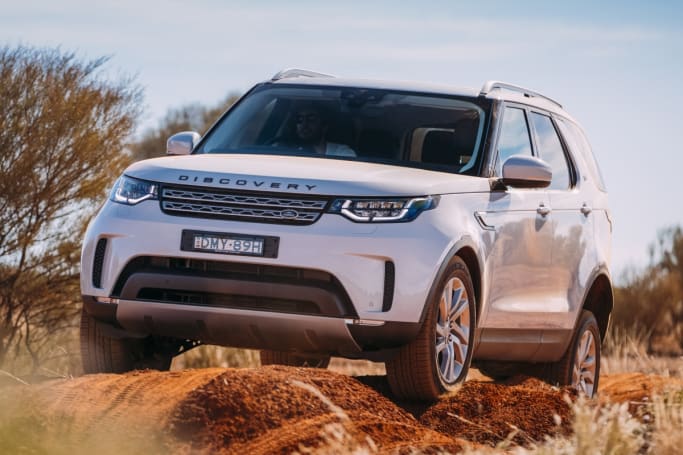
Australia’s outback famously offers up very little in the way of cornering, but the few we did encounter had us a little concerned with the top-heavy nature of the Discovery, with sharp direction changes sending passengers into a noticeable wobble.
Still, our limited wheel time means we’ll be reserving final judgement until we can spend more time with each variant, but our taste-test sample reveals a car that does appear to straddle that line between capable and comfortable.
Basic Warranty
3 years / 100,000 km warranty
ANCAP Safety Rating

The Discovery range has been awarded the maximum five-star ANCAP safety rating, six airbags (front, front-side and curtain), a reversing camera, AEB and Lane Departure Warning fitted on every model, joining the usual suite of traction and braking aids.
The Discovery range is covered by a three-year, 100,000km warranty, but you can extend that to five years at an extra cost. You can also pre-pay your service costs for the first five years of ownership.
The four-cylinder engines get genuinely impressive service intervals of 24 months/34,000km, while the V6 requires a trip to the dealership every 12 months or 26,000km.
It's a hell of a job, keeping the purists happy. But on first impressions, this new Disco should just about pull it off. Comfortable on the road, and capable of tackling anything its owners are likely to throw at it off it. Be prepared to spend up if you want a well-optioned one, though.
For us, though, the equipment of the HSE trim level blended with the power of the V6 engine is the pick of the bunch.
| Vehicle | Specs | Price* | |
|---|---|---|---|
| TDV6 Graphite | 3.0L, Diesel, 8 SP AUTO | $45,540 – 52,910 | 2017 Land Rover Discovery 2017 TDV6 Graphite Pricing and Specs |
| TDV6 | 3.0L, Diesel, 8 SP AUTO | $53,350 – 61,270 | 2017 Land Rover Discovery 2017 TDV6 Pricing and Specs |
| SDV6 Se | 3.0L, Diesel, 8 SP AUTO | $61,600 – 70,840 | 2017 Land Rover Discovery 2017 SDV6 Se Pricing and Specs |
| SDV6 Landmark | 3.0L, Diesel, 8 SP AUTO | $66,330 – 76,230 | 2017 Land Rover Discovery 2017 SDV6 Landmark Pricing and Specs |
| Price and features | 7 |
|---|---|
| Design | 8 |
| Practicality | 9 |
| Under the bonnet | 8 |
| Efficiency | 8 |
| Driving | 7 |
| Safety | 7 |
| Ownership | 7 |
$37,499
Lowest price, based on 73 car listings in the last 6 months